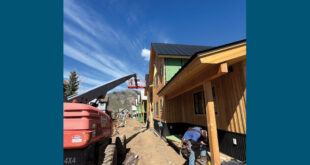“An amenity-based economy doesn’t have to be a poor economy”
Call it tourism tied in with a second-home or lifestyle economy. Use the phrase “amenity-based economy.” Everyone understands that people coming to the area to enjoy themselves is an economic driver in Gunnison County, especially in the Upper East River Valley. But now the most extensive study ever done confirms that understanding.
The Center for Applied Research is constructing a comprehensive economic model of the area, sponsored by the Red Lady Coalition. The goal is to measure the extent to which the local economy is driven by activities based on enjoyment of things like open space, hiking, biking, skiing, fishing and clear night skies. The model also will look at the impact a proposed molybdenum mine on Mt. Emmons might have on the various components of this economy.
“We all knew a couple of things intuitively and one is that an amenity-based economy played a huge part in the county,” explained Red Lady Coalition president Bill Ronai. “What this study shows is that it is really big for the entire county and in particular for the area between Gunnison and Mt. Crested Butte.”
Phase One of the study tabulated that 34 percent, or approximately $238 million, of the county’s overall Gross Regional Product (GRP) is generated by an “amenity-driven or lifestyle economy,” Ronai said. “The Red Lady Coalition believes it is critical to build on this strong platform and not damage its base.”
Ronai said it appears that well over half of the GRP in the Gunnison to Mt. Crested Butte corridor is amenity-driven. He said previous studies had put a version of the lifestyle economy at about 11 percent of the Gunnison County GRP.
Phase Two of the study will focus on the Gunnison-Mt. Crested Butte corridor. Surveys will poll the socio-economic behavior of full- and part-time residents. It will ask winter and summer visitors why they come here; how they spend their money; and where they spend it, etc. The surveys will go on to measure how their behavior might change in response to a variety of factors, including the presence of the proposed Mt. Emmons molybdenum mine.
Phase Three of the study will evaluate the impact of a molybdenum mine on the local economy. Ronai said both the second and third phase of the study should take place sometime in the near future.
“There is nothing earth shattering in the first phase,” said Ronai. “But it gave us a baseline with which to begin to understand the dynamics of this economy. This area competes primarily with approximately 22 other communities similar to ours in the Western U.S. and Canada that rely on recreation- and amenity-oriented activities as a basis for their economy. We need to focus on our competitive advantages to assure long-run prosperity.”
According to the study, government-driven jobs follow amenity-based jobs in the Gunnison County. The Somerset coal mines are the third largest driver in the county in most categories.
The study also indicates that while those earning a living in the amenity-based sector make about $29,000 in Gunnison County, similar jobs in other communities can actually make twice that. “An amenity-based economy doesn’t have to be a poor economy,” Ronai said.
According to a Red Lady Coalition press release, the Phase One model was based on public, verifiable data from the Colorado Department of Local Affairs, Division of Local Government, the Colorado Department of Labor, the Gunnison County Assessor, the U.S. Forest Service and various other published sources.
“We do not believe that our amenity and recreation economy can withstand the introduction of a major, centrally located mine in the valley,” Ronai stated. “But we are not an anti-economic development non-profit. We believe we need to strengthen our current economy so that mining is less attractive to working people in our valley who are fighting to stay here and prosper here.”
 The Crested Butte News Serving the Gunnison Valley since 1999
The Crested Butte News Serving the Gunnison Valley since 1999

